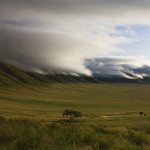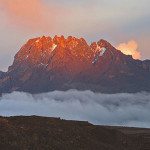It may be cold at Uhuru Peak these days, but that wasn’t always the case. Kilimanjaro is made up of not just one but three dormant volcanoes, and while they haven’t erupted any time recently, the mountain’s explosive history isn’t as far in the past as you might think!
Situated near the fault-line of two tectonic plates, Kilimanjaro began to build itself up around 750,000 years ago, via thousands of years of lava explosions from the volcanic cones of Shira, Mawenzi, and Kibo. One by one, the three cones died out: Shira was the first to go, collapsing once it had reached around 16,400. Kibo and Mawenzi continued to erupt, forming the ridge now known as “the saddle,” before Mawenzi died out at a height of about 18,000 feet. Kibo continued to explode until somewhere between 150,000 and 200,000 years ago, by which point it had reached the 19,341 foot elevation we know today (it’s possible Kibo reached even higher back then; since Kilimanjaro stopped erupting, the biggest change in its height has come from erosion by the elements).
 The Somalia Plate and the African Plate have been slowly pulling apart for hundreds of thousands of years, which caused volcanic activity along the Great Rift Valley (including at Kilimanjaro)
The Somalia Plate and the African Plate have been slowly pulling apart for hundreds of thousands of years, which caused volcanic activity along the Great Rift Valley (including at Kilimanjaro)
By Sting and Rémih [CC BY-SA 2.5 (http://creativecommons.org/licenses/by-sa/2.5)], via Wikimedia Commons
But just because the peaks had stopped building themselves up, that didn’t mean Kilimanjaro was going to settle down into a quiet middle age. Though there haven’t been any major eruptions in a very long time, steam and sulfurous gasses still escape from fumaroles near Kibo’s peak, and in 2003, scientists reported that molten magma still flows just 400 meters beneath the summit.
 It may be dormant, but Kili isn’t extinct…
It may be dormant, but Kili isn’t extinct…
Photo: Thomson Safaris guest, Knic Ebel
–
Eventually, Kili could erupt again (or collapse), but scientists don’t expect any volcanic activity from Kili in the foreseeable future. So trekkers have nothing to fear…except maybe those sulfur-smells near the top!






